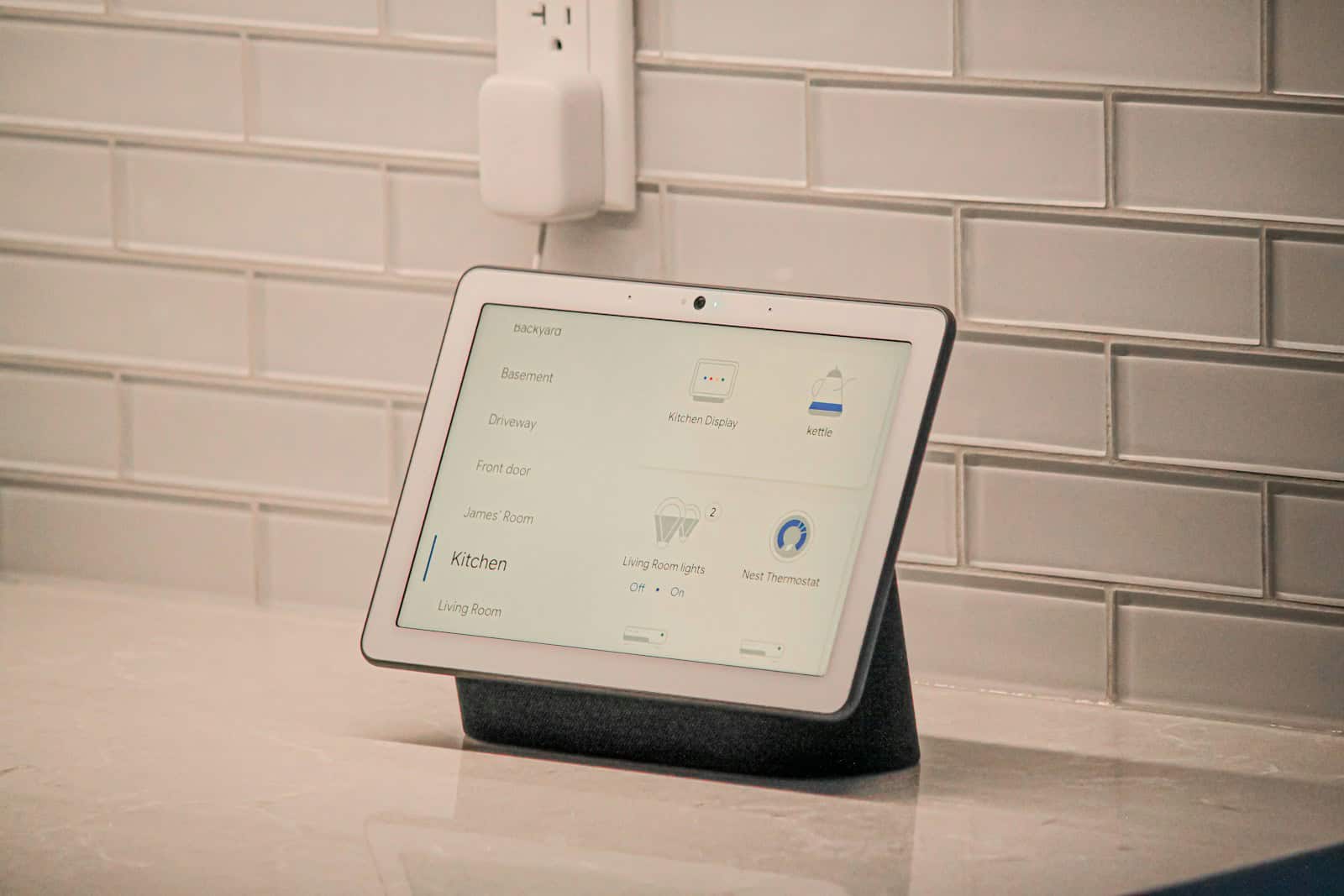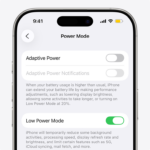Smart displays have become central hubs for connected homes, blending voice assistant capabilities with touchscreens for a richer user experience. In 2025, these devices are smarter, faster, and more privacy-conscious than ever.
Whether you’re managing smart home devices, making video calls, or checking your calendar, here’s a look at the best smart displays for home connectivity in 2025.
1. Google Nest Hub Max (2nd Gen)

Best Overall Smart Display
Why It’s Great:
The updated Nest Hub Max offers powerful Google Assistant integration, Matter and Thread support, and enhanced camera features that make it a top-tier smart home command center.
Key Features:
- 10-inch HD display with adaptive brightness
- Built-in Nest Cam with gesture control
- Works with Google Home, Matter, and Thread
- Face Match for personalized info
Perfect For: Google ecosystem users who want rich control over their smart home, security features, and high-quality video calls.
2. Amazon Echo Show 15 (with Fire TV integration)

Best for Wall-Mounting and Visual Organization
Why It’s Great:
The large 15.6″ display doubles as a digital bulletin board and a streaming device. With widgets, calendar views, and Fire TV access, it’s a productivity powerhouse for families.
Key Features:
- 15.6″ Full HD touchscreen
- Fire TV integration for streaming apps
- Visual ID and voice recognition
- Alexa Widgets for to-do lists, smart home controls, and more
Perfect For: Families who want a central hub for schedules, shopping lists, video calls, and entertainment.
3. Apple Home Hub (Speculated/HomePod Display Hybrid)
Best for Apple Users (Expected Late 2025)
Why It’s Great:
While still rumored as of mid-2025, Apple is expected to release a smart display with deep iOS and HomeKit integration. It may combine iPad-like functionality with HomePod audio and Apple Intelligence AI.
Expected Features:
- iOS-style UI with adaptive home controls
- Integration with Apple Intelligence and Siri
- FaceTime and continuity features
- High-end audio quality
Perfect For: Apple households waiting for a seamless smart display solution that merges perfectly with iPhones, iPads, and Macs.
4. Meta Portal Plus (3rd Gen)

Best for Video Calling and Meta Integration
Why It’s Great:
Despite Meta scaling back hardware, Portal remains a favorite for Messenger and WhatsApp calls. The 3rd Gen version adds better privacy controls and cross-platform compatibility.
Key Features:
- 14-inch rotating screen with smart camera tracking
- Facebook, WhatsApp, and Zoom integration
- Auto-framing and noise cancellation
- Voice assistant support (Alexa built-in)
Perfect For: Families and remote workers who prioritize video calls with excellent tracking and sound quality.
5. Lenovo Smart Display 7 with Google Assistant

Best Compact Smart Display
Why It’s Great:
A great choice for tight spaces, the Lenovo Smart Display 7 delivers core smart display functionality without overwhelming your desk or counter.
Key Features:
- 7-inch display with front-facing speakers
- Google Assistant support
- Physical camera shutter and mute switch
- Affordable and compact
Perfect For: Bedrooms, small kitchens, or home offices needing basic display features in a minimal footprint.
6. Amazon Echo Show 8 (3rd Gen, 2024 Release)

Best Mid-Sized Alexa Display
Why It’s Great:
The redesigned Echo Show 8 features improved spatial audio and an adaptive interface that customizes based on proximity and usage.
Key Features:
- 8-inch HD display with edge-to-edge glass
- Adaptive content and widgets
- Built-in smart home hub (Matter and Zigbee)
- Upgraded audio for music and video
Perfect For: Alexa users who want a versatile smart display that fits on a nightstand or kitchen counter.
Final Tips for Buying a Smart Display in 2025:
- Ecosystem is key: Choose based on whether you’re in the Apple, Google, or Amazon smart home ecosystem.
- Look for Matter support: Ensures compatibility across platforms.
- Camera and privacy: Opt for physical shutters or automatic privacy modes if security is a concern.
- Display size matters: Pick the right size depending on where you’ll use it (bedroom vs. kitchen vs. living room).
Breakdown Of Some Popular Smart Displays
Smart displays have become a popular addition to many homes in recent years. They combine the helpfulness of voice assistants with screens that show useful information, photos, and videos. The Amazon Echo Show 8 is the top overall pick for smart displays in 2025, but there are great options for every budget and use case.
These handy devices can sit on your kitchen counter to show recipes, perch on your nightstand as a fancy alarm clock, or help you control your smart home from anywhere in the house. Some people prefer Google’s Nest Hub displays while others like Amazon’s Echo Show lineup due to their different features and looks. Your choice depends on which voice assistant you want and what you plan to use the display for most often.
1. Amazon Echo Show 8
The Amazon Echo Show 8 stands out as one of the best smart displays on the market in 2025. It features an 8-inch HD touchscreen that brings visual elements to your smart home experience.
This device comes packed with room-filling spatial audio, making it great for playing music or watching videos. The sound quality has improved significantly from earlier models.
The newest model includes a centered, auto-framing camera that makes video calls clearer and more natural. It keeps you in frame even when you move around the room.
Smart home fans will appreciate the built-in smart home hub. This feature lets you control compatible devices without needing extra hubs or bridges.
You can use the Echo Show 8 in the kitchen to follow recipes, set timers, or make shopping lists. The screen shows step-by-step cooking instructions while Alexa responds to voice commands.
The device comes in different colors, including Glacier White. This gives users options to match their home decor.
According to recent rankings, the Echo Show 8 is highly rated among smart displays. It’s listed as the third best-selling smart display on Amazon.
Some experts consider it the best digital kitchen assistant. The screen size works well on kitchen counters without taking up too much space.
The Echo Show 8 competes closely with the Google Nest Hub. While CNET ranks the Google Nest Hub as the best overall, they list the Echo Show 8 as “the other best smart display.”
PCMag names the Echo Show 8 as their top pick overall for smart displays in 2025. They praise its balance of features, size, and price.
Alexa powers the Echo Show 8, giving users access to thousands of skills. You can check the weather, play games, hear news updates, or control other smart devices with simple voice commands.
The price point makes it a mid-range option that balances features and value. It costs more than mini smart displays but offers much better sound and screen quality.
2. Google Nest Hub Max
The Google Nest Hub Max stands out as a powerful smart display with a large 10-inch screen. This size makes it perfect for watching videos or making video calls from across the room.
Unlike its smaller sibling, the Nest Hub Max includes a built-in camera. This camera enables video calling and also works as a Nest security camera when you’re away from home.
The display automatically adjusts to match the lighting in your room. It can blend with over 16 million combinations of light and color, making your photos look natural on screen rather than artificially bright.
Sound quality on the Nest Hub Max exceeds what you’ll find in the standard Nest Hub. The larger speaker drivers create fuller sound that fills bigger rooms more effectively.
Google Assistant powers the device, letting users control smart home gear, check calendars, or get answers to questions. Voice commands work well even from a distance.
The kitchen makes an ideal spot for this smart display. Its screen shows recipes while you cook, and you can control it with messy hands using just your voice or gestures.
When comparing options, the Nest Hub Max costs more than the standard Nest Hub. But the larger screen and better speakers justify the price for many users.
Privacy features include a physical switch to disable the camera. This small touch helps users feel more comfortable having the device in private areas of their home.
Photo display features turn the Hub Max into a digital picture frame when not in use. Google Photos integration makes it simple to show your latest pictures automatically.
Smart home controls appear clearly on the screen. Users can adjust lights, thermostats, and other connected devices with taps or voice commands.
3. Lenovo Smart Display
Lenovo Smart Display brings Google Assistant to life with a visual screen. It comes in two screen sizes – 8 inches and 10 inches – to fit different spaces in your home.
The Lenovo Smart Display shows information in a more engaging way than voice-only assistants. Users can see weather forecasts, calendar events, recipes, and more at a glance.
Sound quality is one of its strong points. Many users choose the Lenovo model specifically because it offers better audio than some competitors.
The 10-inch model works well as a hub for smart home control. It lets users check security cameras, adjust thermostats, and control lights with simple voice commands or touches.
For smaller spaces, the 8-inch version offers the same features in a more compact size. It fits nicely on bedside tables or kitchen counters.
Video calling is simple with the built-in camera. The 10-inch model is perfect for family video chats with its wider screen.
When not in use, the display turns into a digital photo frame. It can show personal photos or artwork.
Privacy features include a physical camera shutter and microphone mute button. These give users peace of mind when the device isn’t needed.
The smart display can stream music and videos from popular services. This makes it useful for kitchen entertainment while cooking.
Setting up routines is easy. Users can program the device to show specific information at certain times of day.
The Lenovo Smart Display 10 works especially well for monitoring children or checking who’s at the front door. Its larger screen shows more detail.
Voice control makes hands-free operation simple. This is helpful when cooking with messy hands or doing other tasks.
The clean design fits most home styles. With its white front and bamboo or gray back, it looks more like furniture than tech.
4. Amazon Echo Show 10
The Amazon Echo Show 10 stands out in the smart display market with its unique motion feature. This smart display has a 10.1-inch HD screen that moves to follow you around the room. When you’re on video calls or watching content, the screen stays in your view no matter where you move.
Released as the third generation in Amazon’s Show lineup, this model builds on earlier versions with better sound and screen quality. The automatic motion tracking works well in kitchens or living spaces where you might be moving while interacting with the device.
Alexa powers the Echo Show 10, making it easy to control smart home devices, get weather updates, or check your calendar. You can ask questions and get visual answers right on the screen.
The built-in camera works for video calls and home monitoring. You can check your home remotely through the Alexa app when you’re away, adding security features to its list of functions.
Sound quality on the Echo Show 10 is impressive for a smart display. The speakers provide rich audio that fills a room, making it good for both music and video content.
Kitchen users will find the recipes and cooking videos helpful, as the screen follows along while you move between counters and cooking areas. The hands-free experience works well when your hands are busy cooking.
Privacy features include a physical camera shutter and microphone off button. These let you control when the device can see or hear you, addressing common privacy concerns.
The Echo Show 10 takes up more counter space than smaller displays due to its moving base. You’ll need to allow room for the screen to rotate without hitting objects nearby.
While pricier than basic smart speakers, the motion tracking feature makes it one of the most advanced smart displays currently available. For people who move around while using their smart device, this feature adds real value.
5. Google Nest Hub
Google offers two main smart displays in its Nest Hub lineup. The standard Nest Hub has a 7-inch screen with one speaker driver, while the larger Nest Hub Max features a 10-inch display.
The second-generation Nest Hub makes a great bedside companion. It lacks a camera, which many users appreciate for privacy in bedroom settings. This design choice sets it apart from many competing smart displays.
Google’s smart displays excel at showing your daily schedule. They integrate well with Google Calendar, giving you quick access to your appointments and reminders at a glance.
The Nest Hub works as a central control point for your smart home. Users can manage lights, thermostats, security cameras, and other compatible devices through the touchscreen or voice commands.
For entertainment, these devices stream music, podcasts, and videos from services like YouTube and Netflix. The sound quality is good for casual listening, though audiophiles might want additional speakers.
The Nest Hub Max offers more features than its smaller sibling. Its larger screen makes video content more enjoyable, and the built-in camera enables video calls and security monitoring.
Both models support hands-free cooking help with step-by-step recipe instructions. This function proves especially useful in the kitchen when your hands are messy or busy.
Sleep sensing technology in the newer Nest Hub models tracks your sleep patterns without requiring you to wear any devices. It uses motion sensing rather than cameras to respect privacy.
Google Assistant powers the experience on these displays. Ask questions, set timers, check weather forecasts, or control your smart home with simple voice commands.
The Nest Hub starts at a lower price point than the Max version, making it more accessible. Some retailers list the standard Nest Hub at around $100, while the Max costs more due to its larger screen and added features.
Many users praise the photo frame feature. When not in active use, these displays can show your Google Photos albums, turning them into digital picture frames.
6. Amazon Echo Spot
The Amazon Echo Spot is a compact smart display that packs useful features into a small package. Released in 2024, this device brings back the circular design from years ago but with modern upgrades.
It works perfectly as a bedside alarm clock with its small footprint. Users can set and change alarms easily, which makes morning routines smoother.
The Echo Spot offers surprisingly helpful features despite its size. It handles most common smart display tasks without taking up much space on a nightstand or desk.
Sound quality is impressive for such a small device. The Spot delivers clear audio that fills a bedroom or small office nicely.
The circular screen shows time, weather, and other helpful information at a glance. Some users find the clock display particularly easy to read compared to other smart displays.
Alexa integration allows voice control for smart home devices, music playing, and answering questions. This hands-free control adds convenience, especially when you’re busy or in bed.
The design includes a sneaky surprise feature that many users enjoy. Its stylish look fits well in most home decor styles.
For those who want a smart display without the bulk, the Echo Spot hits a sweet spot. It costs less than larger models while keeping core functions intact.
Video calling works on the Spot, though the smaller screen size means it’s better for quick chats than long conversations. The camera quality matches what you’d expect for the price point.
The Echo Spot falls between a smart speaker and full-sized smart display. It takes up minimal space while offering visual feedback that basic speakers lack.
Sleep features like white noise and gentle wake-up lighting make it especially useful in bedrooms. These functions help create better sleep habits for many users.
7. Facebook Portal Plus
The Facebook Portal Plus stands out with its 14-inch HD display that puts it among the largest smart displays on the market. This tilting screen gives users flexibility to adjust the viewing angle for the perfect video call setup.
Video calling is where the Portal Plus truly shines. It features a camera that tracks movement and keeps you in frame during calls, similar to the Echo Show 10. This means you can move around your kitchen while cooking and still remain visible to friends or family.
The display quality on the Portal Plus is impressive. Reviews indicate it has the sharpest screen seen on a smart display, making video calls look crisp and clear. This makes a big difference when connecting with loved ones.
Audio quality doesn’t disappoint either. The Portal Plus comes with hi-fidelity audio that enhances both music playback and call clarity. The speakers deliver rich sound that fills most rooms easily.
Like many smart displays, the Portal Plus has Alexa built-in. This integration lets users set reminders, check calendars, control smart home devices, and more through voice commands.
The hands-free calling feature makes the Portal Plus especially user-friendly. You can start video calls without needing to pick up the device, perfect for busy moments when your hands are occupied.
One key selling point is the Portal Plus’s focus on family connections. The large screen makes group calls more engaging, as you can see everyone clearly. This size advantage becomes apparent during multi-person conversations.
The wedge-shaped design gives the Portal Plus a modern look that fits well in most home settings. Its tilting mechanism feels sturdy and well-built, allowing for various viewing positions.
While the Portal Plus costs more than the standard Portal models, the larger screen and premium features justify the price for those who make frequent video calls. Power users will appreciate the extra screen real estate.
For homes with multiple rooms, the tracking camera proves particularly valuable. It follows the action naturally, creating a more dynamic calling experience than static-camera competitors.
8. Skylight Calendar Display
The Skylight Calendar stands out in the smart display market as a specialized family organization tool. It features a 15-inch HD touchscreen that makes planning and viewing family events simple and clear.
Unlike other smart displays that try to do everything, the Skylight Calendar focuses on one main job – keeping families organized. This focused approach means it does its primary task very well.
The display runs on an Android-based operating system and shows a calendar at all times. Families can see their schedules in different views to fit their planning needs.
One key feature is the free mobile app that connects to the display. Family members can update the calendar while away from home, and changes show up on the main display right away.
The Skylight Calendar also works as a chore chart, helping parents assign tasks to children. This extra function adds value beyond basic scheduling.
For busy households, the WiFi-connected display makes coordination much easier. Everyone can see who needs to be where and when without checking multiple phones or paper calendars.
The display looks like a high-end tablet and adds a modern touch to any wall or countertop. Its clean design fits well in kitchens, living rooms, or hallways where family members pass by often.
When choosing between smart calendars, consumers often compare the Skylight Calendar with competitors like the Hearth Display. Both aim to improve family planning, but each has its own interface style.
The Skylight Calendar’s user interface is designed to be picked up quickly by all family members. Even young children and less tech-savvy relatives can learn to use it with little instruction.
For families struggling to stay organized with busy schedules, the Skylight Calendar offers a central hub for all activities. The visual display makes conflicts and free time immediately obvious to everyone.
9. Lenovo Smart Clock
The Lenovo Smart Clock offers a practical solution for those seeking a smart display designed specifically for the bedroom. Its compact size and focus on time-keeping functionality make it different from larger smart displays.
Lenovo offers several models in their Smart Clock lineup. The Smart Clock Essential features a simple, easy-to-read LED display that shows just the basics – time, temperature, and weather conditions. This no-frills approach works well for users who want simplicity.
For those wanting more features, the Lenovo Smart Clock with Google Assistant offers a touchscreen display with customizable clock faces. Users can control smart home devices, check calendars, and enjoy music right from their nightstand.
A key bedroom-friendly feature across all models is the auto-dimming display. The screen automatically adjusts brightness based on room lighting, ensuring it won’t disturb sleep. At night, it dims significantly to maintain darkness in the room.
The Smart Clock 2 improves upon the original with better sound quality and an optional wireless charging dock. This turns the clock into a charging station for phones and other compatible devices.
Voice assistant integration gives users hands-free control. Depending on the model, the clocks work with either Google Assistant or Alexa, responding to voice commands to set alarms, play music, or control smart home devices.
The alarm functions go beyond basic beeping. Users can choose from numerous alarm tones or wake up to their favorite music or radio stations. The gentle wake option gradually increases volume and screen brightness.
Many users appreciate the easy readability of these clocks, particularly the Essential model. The large, clear digits are visible without glasses or contact lenses, making quick time checks effortless in the middle of the night.
Setup is straightforward through the companion app for either Google or Alexa. Users can customize settings, connect smart home devices, and set routines all from their phones.
The compact footprint of Lenovo’s Smart Clocks means they fit easily on nightstands without taking up much space. Their fabric covering and rounded design blend nicely into most bedroom decors.
10. LG XBOOM AI ThinQ
The LG XBOOM AI ThinQ WK9 brings Google Assistant capabilities to a smart display with impressive audio features. This device stands out with its 8-inch touchscreen display that lets users watch videos, make video calls, and check recipes.
Sound quality is a major focus of this smart display. It comes with 20W stereo dual speakers that get quite loud, making it suitable for music playback in medium-sized rooms. The audio technology includes Meridian Audio’s advanced features for better sound performance.
Users can control the LG XBOOM with voice commands through Google Assistant. This hands-free control extends to playing music, making calls, and checking schedules, adding convenience to daily tasks.
The design is modern but not as sleek as some competitors. It blends into home decor while providing easy access to information and entertainment options.
For smart home integration, the XBOOM connects with compatible devices through Google Assistant. This allows users to control lights, thermostats, and other smart home products by voice or through the display.
Price is a consideration with the LG XBOOM. Reviews suggest that while it’s a good smart display, there are less expensive options with similar features available from other brands.
Video call capability is built in, letting users connect with friends and family through the device’s camera and screen. This feature proves useful for staying in touch without needing a phone or computer.
Despite its strengths, the LG XBOOM AI ThinQ doesn’t stand out dramatically from other Google Assistant smart displays on the market. Its audio quality is its main selling point against competitors.
The display shows visual responses to queries, weather updates, calendar events, and other information in an easy-to-read format. Its touchscreen responds well to taps and swipes for manual control.
Understanding Smart Display Technology
Smart displays blend touchscreen interfaces with voice assistants to create interactive hubs for your home. These devices combine visual elements with smart speaker capabilities to offer both information and control in one package.
Key Features and Functionalities
Smart displays come equipped with several essential features that make them valuable additions to any home. Most models include voice assistants like Google Assistant, Amazon Alexa, or Apple’s Siri that respond to verbal commands.
These devices feature high-resolution touchscreens that show useful information such as weather updates, calendars, and news headlines. The screen sizes typically range from 5 to 10 inches, depending on the model.
Many smart displays include built-in cameras for video calls with friends and family. Privacy-conscious users will appreciate the physical camera shutters found on many models.
Smart displays also function as control centers for smart home devices, allowing users to adjust lights, thermostats, and security cameras with simple voice commands or touches.
Comparing Smart Displays to Traditional Screens
Smart displays differ from traditional digital photo frames or tablets by being designed for hands-free operation. They can be controlled entirely by voice, making them more convenient when cooking or completing other tasks.
Smart displays differ from regular screens by being always-on and ready to respond. They don’t require unlocking or navigating through apps to access information or controls.
Traditional screens like tablets need manual interaction, while smart displays can transform based on context—showing recipes in the kitchen, serving as alarm clocks in bedrooms, or becoming digital assistants in living areas.
Power consumption also differs significantly. Smart displays are designed for continuous operation, using less energy than tablets or computers left running all day.
The focused nature of smart displays means they do fewer things than multipurpose tablets but perform their specific functions more seamlessly and efficiently.
Choosing the Right Smart Display
Selecting a smart display requires considering both your household needs and how it will connect with your existing tech ecosystem. Size, screen quality, and specific features vary widely among available options.
Factors to Consider for Home Use
Screen size is a key consideration when buying a smart display. Smaller 5-8 inch displays work well for bedside tables or small spaces, while larger 10-inch models offer better viewing for videos and recipes in kitchens or living rooms.
Display quality matters too. Higher resolution screens show sharper images and text. Some models offer adaptive brightness that adjusts to room lighting conditions.
Audio quality varies significantly between models. If you plan to play music often, look for displays with quality speakers. The Google Nest Hub Max and high-end Echo Show devices typically offer stronger audio performance.
Privacy features are essential. Check if the device has:
- Physical camera shutters
- Mute buttons
- Clear indicator lights when recording
- Easy-to-access privacy settings
Price ranges from $50 to $250 depending on screen size and features. More expensive models typically include better cameras and sound systems.
Integration with Smart Home Devices
Compatibility with your existing tech is crucial. If you use iPhone and Apple services, a Google or Amazon display might not work as smoothly with your devices as you’d hope.
The Amazon Echo Show works best with Ring doorbells, Blink cameras, and other Amazon products. Google Nest Hubs connect seamlessly with Nest thermostats, doorbells, and Chromecast devices.
Most popular smart displays support these common smart home brands:
- Philips Hue lighting
- Ecobee thermostats
- August smart locks
- Many Wi-Fi plugs and switches
Voice assistant preference matters. Google Assistant excels at answering general knowledge questions and integrates with Google services like Calendar and Maps. Alexa works with more smart home devices and offers more skills and custom commands.
Consider which video calling platforms you use most. Echo Shows work with Skype and Amazon’s own calling service, while Google Nest devices use Google Meet and Duo.
Frequently Asked Questions
Smart displays combine visual information with voice control to enhance your home experience. These devices offer a range of functions from video calls to smart home control with varying sizes and features.
What are the top-rated smart displays on the market?
The Amazon Echo Show 8 ranks as one of the most popular smart displays today. It offers a good balance of screen size and functionality at a reasonable price point.
The Google Nest Hub Max stands out with its larger screen and excellent video calling features. Its camera can track your movement during calls, keeping you in frame.
The Echo Show 10 features a rotating screen that follows you around the room. This makes it perfect for video calls and watching content while moving about your space.
Which smart displays offer the best integration with smart home devices?
The Google Nest Hub devices work well with Google Home products and many third-party smart home brands. They offer simple touch and voice controls for lights, thermostats, and cameras.
Amazon’s Echo Show lineup connects seamlessly with Ring doorbells, security cameras, and other Alexa-compatible devices. The visual interface makes managing your smart home easier than voice-only speakers.
Lenovo Smart Displays run on Google’s platform, giving them the same wide compatibility as the Nest Hub devices. They can control thousands of smart home products with simple commands.
What features distinguish the Lenovo Smart Display from its competitors?
The Lenovo Smart Display offers a unique bamboo back design on some models. This gives it a more furniture-like appearance that blends better with home décor.
It provides excellent sound quality with powerful speakers. The audio output is strong enough to fill most rooms with clear, rich sound.
The device includes a physical camera shutter for privacy protection. This feature lets users mechanically block the camera when not in use, addressing common privacy concerns.
What enhancements have been made in the latest version of Google Nest Hub?
The newest Google Nest Hub includes improved sleep tracking technology. It can monitor your sleep patterns without requiring you to wear any devices.
Google has upgraded the speaker system for better sound quality. The bass response and overall audio clarity have been enhanced compared to earlier models.
The latest version features faster processing and more responsive touch controls. These improvements make navigating the interface smoother and more intuitive.
How do smart displays vary in screen size, and what are the benefits of a larger display?
Smart displays range from 5 inches to 15.6 inches in screen size. Smaller displays like the Google Nest Hub work well on nightstands or small counters.
Mid-sized displays (8-10 inches) like the Echo Show 8 strike a good balance. They’re large enough to view content from across a room but compact enough for most spaces.
Larger displays like the Echo Show 15 can show multiple information widgets at once. They excel at family calendars, recipe viewing, and watching videos from across the room.
What are the pros and cons of using a smart display as a television accessory?
Smart displays can show camera feeds from connected doorbells and security cameras. This lets you check who’s at the door without leaving your couch.
They can control smart TVs and streaming devices through voice commands. This adds convenience when searching for content or adjusting volume.
However, smart displays have smaller screens than dedicated TVs. Even the largest 15-inch models don’t replace a proper television for extended viewing.
These devices may also have more limited streaming app selection. While they support major services like Netflix and YouTube, they may not have every app available on smart TVs.







